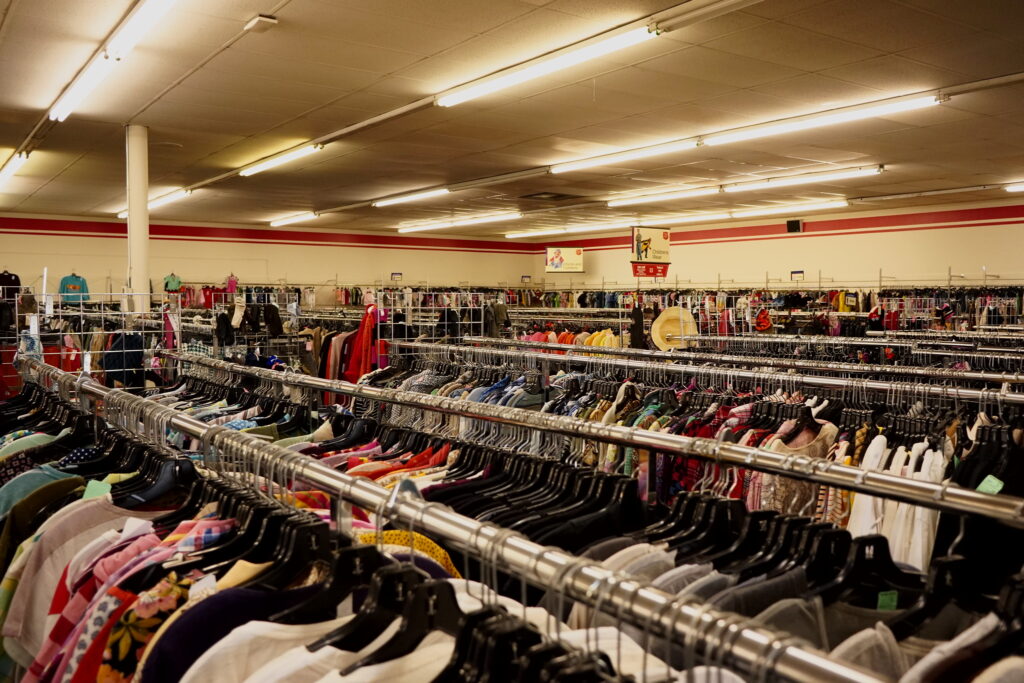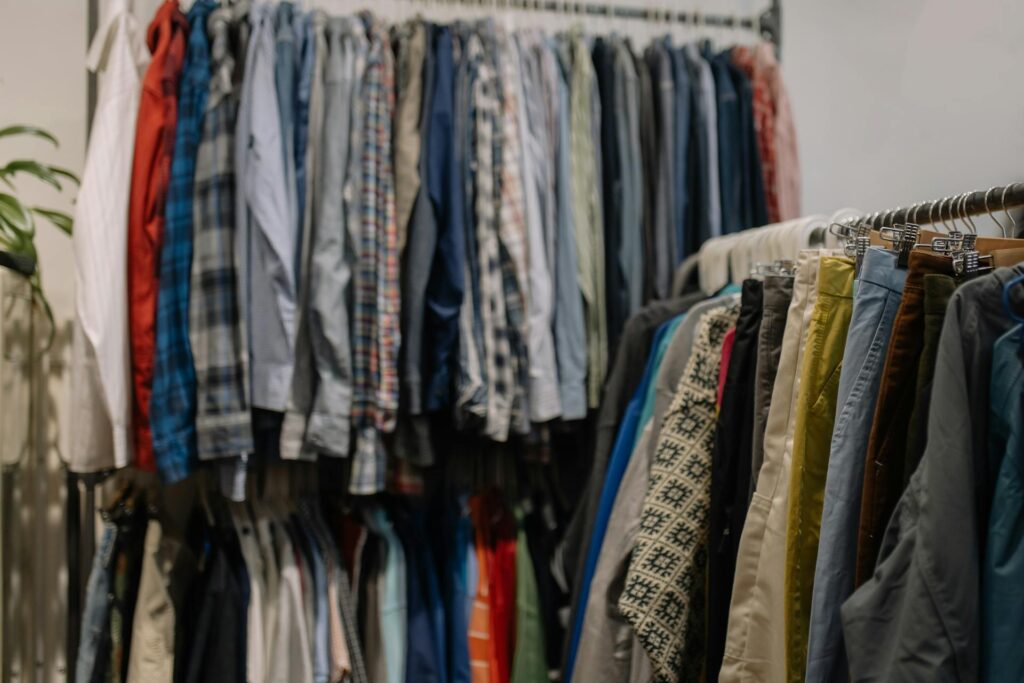
Thrifting comes naturally to me, it is more than just a habit, it is a way of life”, MaryLynn said. MaryLynn, a former flight attendant, has been thrifting for as long as she can remember. “When you have 12 sisters and brothers, resourcefulness is a necessity”, she said.
Marylynn got into thrifting from her family, especially her dad who loved auctions. She recalls pitching in to help him when she was younger. Growing up in a big family of twelve, they understood the importance of saving money, which became a core value for them. “This taught me the value of a dollar”, she said.
It is common for people to start thrifting at separate times in their lives. Some start early because of financial reasons, while others join later because they become more aware of the environmental benefits of thrifting.
“Thrifting is a secondhand economy. It is reusing items and giving them a second chance” Dr. Leila Zakhirova said. Dr. Zakhirova is a political science and environmental and sustainability studies professor in the state of Minnesota.
Looking around her house, MaryLynn proudly says that almost everything in there is thrifted.
For many people, thrifting is a hobby they enjoy. But for some, they might think it is not worth their time, while for others, it is a must-do because of their financial situation. Whatever drives people to thrift, it is getting a lot more popular with the younger generation these days.
“Thrifting has become a cool thing”, Dr. Zakhirova said.
Thrifting, once seen as a shopping option for only those on tight budgets, has undergone a remarkable makeover in recent times. It is no longer just about finding cheap goods; it has become a celebrated lifestyle choice, thanks to social media influencers who have made it a trend. But, according to her, social media influencers are not the sole reason for the rise of the thrifting culture among the younger generation.
Dr. Zakhirova teaches a course on sustainability issues where she and her students discuss the issue of fast fashion. She said, “The younger generation is now more aware of sustainability issues than older generations because climate change is happening during their lifetime.”

As thrifting gains popularity and becomes increasingly trendy, a crucial question emerges: Are we thrifting with purpose?
Thrifting with purpose extends beyond merely searching for specific items. It involves understanding the underlying motivation behind thrifting. Are you thrift shopping to reduce your environmental impact? Is it out of necessity? Or are you simply following a trend? Thrifting offers multifaceted benefits.
Thrifting, often seen as a means to buy less and focus on necessities, is actually more complex. According to an article published by Sage Journals:
• Higher-income individuals tend to buy new items without guilt, sometimes choosing “sustainable” products for appearance’s sake (known as green-washing. However, lower income groups also succumb to buying more due to lower prices.
• Second-hand consumption varies across income brackets. For lower-income individuals, it might be a necessity driven by economic constraints, while higher-income individuals may choose it for environmental or lifestyle reasons.
“The goal is to keep all these things that were donated from going into the land field” Dr. Zakhirova said.
Thrifting helps preserve natural resources as well as material resources that go into making the stuff. According to Dr. Zakhirova, thrifting gives nature some time to recuperate from all the things we do to the environment such as deforestation.
According to an article published by Goodwill, thrifting is better for the environment for several reasons:
• Less resource consumption: Thrifting reduces the demand for new items, conserving natural resources such as water and energy that are used in the production process, especially prevalent in industries like fast fashion.
• Fewer things are thrown away: Thrift stores provide a second life to items that would otherwise end up in landfills, combating the issue of overconsumption and waste in today’s society of consumerism.
• Less chemical pollution: By opting for secondhand items, consumers reduce the demand for new products that contribute to chemical pollution. This includes the use of pesticides in textile production and the release of harmful chemicals and greenhouse gases during manufacturing processes, leading to a healthier environment, and potentially reducing health risks for consumers.
“Supporting the thrift stores help way more than just the environment”, MaryLynn said.

Supporting thrift stores also helps charities. Shopping at thrift shops is a form of charity because the proceeds often go to people in need. Genuine thrift shops give back to the community. They typically do not take taxes out of their earnings ensuring that more funds can go towards supporting charitable initiatives.
“When you hunt, anticipation and planning teach you patience”, MaryLynn said.
MaryLynn believes that there is no feeling comparable to the satisfaction of finally finding what you have been searching for, even if it takes hours, days, or even weeks to uncover.
“The unique part of thrifting is the surprise element”, Dr. Zakhirova said.
When you thrift, you are never fully certain of what you are going to find and this aspect forces people to be open-minded, according to Dr. Zakhirova.
“You only get one shot at it”, MaryLynn said.
Thrift stores offer a unique experience compared to traditional retail shops. Unlike traditional retail shops where items are standardized and plentiful, thrift stores present a diverse array of pre-loved goods waiting to be discovered. Each visit is an opportunity to stumble upon one-of-a-kind finds, fostering a sense of excitement and adventure.
“Thrifting can also promote more consumption and have unethical side effects”, Dr. Zakhirova said.
Ethical consumption is about knowing your limits. Being mindful about the things you bring into your household. Just because you desire something does not necessarily mean you require it.
“We are Americans, we buy things because we want them, not because we need them” MaryLynn said.
It is dangerously simple to succumb to the allure of consumer culture, omnipresent in our daily lives. With each passing day, a plethora of new inventions emerges, each marketed as indispensable for our happiness. Among the myriad industries perpetuating this mindset, the fast fashion industry stands out as one of the most prominent.
According to Dr. Zakhirova, fashion trends exert pressure on us to constantly purchase new items, leading to a cycle of acquiring and subsequently donating possessions.

Unfortunately, not every item gets the chance of a second life. Due to limited space and turnover policies, some thrift stores dispose of unsold items within a month by sending them to landfills or shipping them to developing countries.
“Just because I do not trash it does not mean it will not be trashed by somebody else”, Dr. Zakhirova said.
The thrifting culture alleviates the guilt associated with purchasing more items and indulging in our consumer habits. It becomes a mental game, providing a sense of justification for our actions.
“Thrifting is here to stay”, MaryLynn said.
Thrifting is inherently noble, as it contributes to environmental preservation by countering the detrimental effects of fast fashion on our planet.
“Fast fashion is the Cinderella dress that disintegrates at midnight”, Dr. Zakhirova said.
Fast fashion entails the rapid production of low-quality items. The fast fashion industry is significantly contributing to environmental degradation. It is imperative for the fashion sector to decelerate its pace.
According to Dr. Zakhirova, true progress cannot be achieved until the fast fashion industry dies.
In the meantime, it is crucial to maintain our intentionality when thrifting and adapt our lifestyles to further prevent the detrimental impact of fast fashion on our environment.
In the vibrant tapestry of modern consumerism, thrifting emerges as more than just a pastime or a trend. “It is a whole lifestyle”, MaryLynn said.



